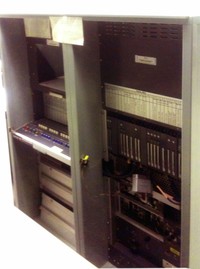|
In the early 70s Marconi Radar Ltd built it's own mini computer the Locus 16 for use in radar systems. It was almost a micro as it used bit slice chips. However it had interrupts and peripherals but it also had LOCKS to be used as a multi-processor system with a general purpose CPU card a display processor, shared RAM. The Locus 16 was used in conjunction with the Ferranti 1600B and 1600 E computer suystems
Locus 16, a Marconi-developed 16-bit minicomputer, programmed in Coral66, a (then) high-level language. Programs were prepared using teletypes and reels of paper tape. Tapes were taken twice a day to a computer on a research site some five miles away to be run in batches, compiled, results returned, the inevitable errors to be corrected and submitted for the next batch run.
Despite the high-level programming language used, the Locus 16 had primitive diagnostic capabilities - a special control board, connected to the primary bus of the computer. The diagnostic panel's principal features were sixteen keys, arranged in groups of four (hex) each with an associated led. The keys had two fixed positions to set-up a sixteen bit/ four hex value. With the addition of other keys one could sense (read) and write data into individual memory addresses and monitor processor registers on the machine (e.g. address data, instruction).
This system was used in conjunction with the Sea Wolf a naval guided missile system designed and built by BAC, later to become British Aerospace (BAe) Dynamics (now MBDA). It is an automated point-defence weapon system designed as a final line of defence against both sea-skimming and high angle anti-ship missiles and aircraft. It has been fielded by the Royal Navy in two versions: the GWS-25 Conventionally Launched Sea Wolf (CLSW) and the GWS-26 Vertically Launched Sea Wolf (VLSW) forms.
Shipborne trials of the Seawolf were carried out on a modified Leander class frigate, HMS Penelope, from 1976 onwards. Sea Wolf was tested with a vertical launch system early in the missile's development on a modified Loch class frigate, Loch Fada, but for unclear reasons work did not continue in this direction: the GWS-26 "VL Seawolf (VLS)" being a much later (1980s) development. During trials the missile performed impressively, successfully intercepting a 114 mm shell on one occasion.
The first deployment, in the GWS-25 form, was on the Type 22 frigate (2 systems) and later on modified Leander class frigates (1 system) in six-round, manually loaded, trainable launchers.
It has been used by the Royal Navy since 1979 and was fired in anger during the Falklands War. Current deployment is the GWS-25 Mod 3 system on the Type 22 Batch 3 and the GWS-26 Mod 1 system on Type 23 frigates. The latter fields 32 vertical launch missiles (VL Sea Wolf) in its missile silo. It is expected to remain in service until 2020.
This exhbit was purchased from the MOD with the generous support of follows and friends on Twitter and FaceBook. Read More >>>
Manufacturer: Marconi
Date: 1974
Comment on This Page
Other Systems Related To Marconi Locus 16:
This exhibit has a reference ID of CH16843. Please quote this reference ID in any communication with the Centre for Computing History.
|
|
Click on the Image(s) For Detail
|












